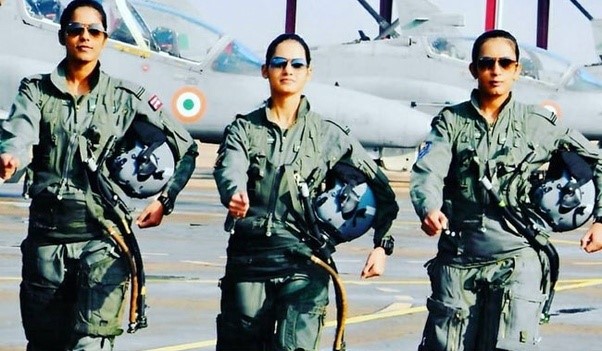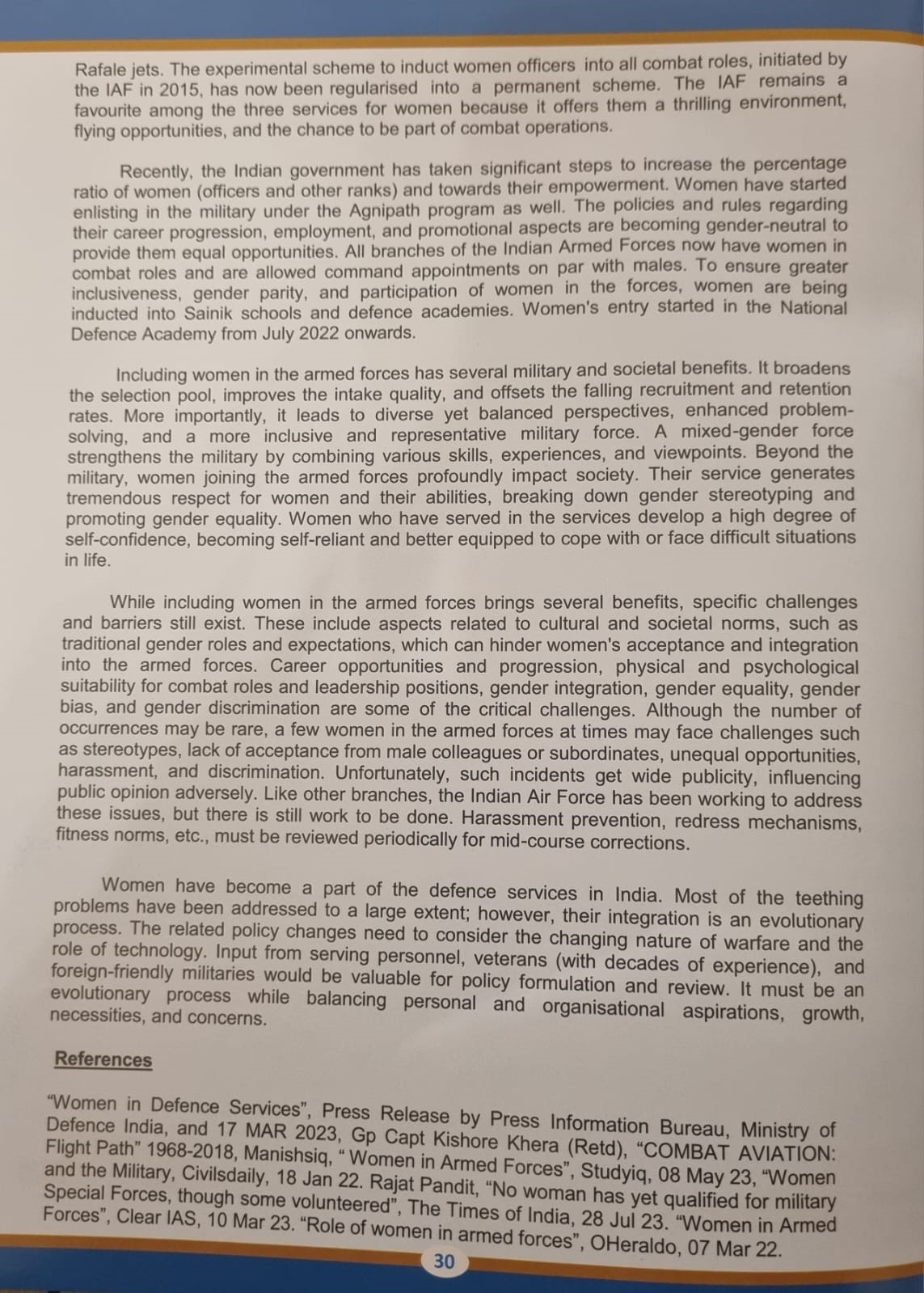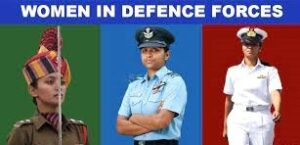
My Article published in the Air Force Association Journal 2024
“Valour knows no gender.”
– Barack Obama
Women’s participation in the armed forces has evolved significantly over the years worldwide, with a growing recognition of their valuable contributions to the defence and security of the country. Many countries now allow women to serve in the armed forces in numerous roles. The extent of participation and roles vary from country to country, depending on cultural norms, legal frameworks, and military policies. Traditionally, the Indian armed forces have also been predominantly male-dominated; however, changes in societal norms and perceptions made the inclusion of women inevitable. Over the years, women’s roles and opportunities have expanded, with women now serving as pilots, engineers, and administrators, among other roles.
The history of women in the Indian defence services is a story of gradual progress and increasing participation from support services and roles to combat and command roles. The Indian Air Force, for instance, has implemented various initiatives to promote gender equality and equal opportunities for women. These include recruitment drives, training programs, and policy changes. However, it is essential to note that the journey hasn’t been without its challenges. The IAF has had to overcome societal norms, cultural barriers, and even some resistance within its ranks to pave the way for women’s inclusion. Despite these hurdles, the IAF has been relatively more progressive than the three services in gender mainstreaming, with significant strides made in recent years towards achieving gender equality and providing equal opportunities for women in the workforce.
Last year, the Minister of State for Defence shared information in the Lok Sabha about the number of women serving in the armed forces. According to the information shared, the total number includes officers, other ranks, and those in medical, dental, and nursing services. The number of women personnel employed in the three services, excluding those in medical, dental, and nursing, comes to 4,948. The exact numbers in each service vary; reports in the open domain suggest that percentage-wise, the women’s strength in the Army is approximately 3.8% compared to 13% of the Air Force and 6% of the Navy. The IAF employs the most significant percentage of women officers among the three armed forces. The strength of women officers in the IAF (excluding Medical and Dental branches) is 1,636.

The Indian Air Force has been at the forefront of gender integration, with women being inducted into the force since 1992. In IAF, Women serve in various roles, including flying (fighter jets, transport aircraft, and helicopters), and also hold influential positions in other ground duty branches like administration, logistics, air traffic control, engineering, meteorology, accounts, and judge advocate general along with their male counterparts. IAF follows a gender-neutral approach to the employment of women. They are considered at par with their male counterparts, with no differentiation in type and quantum of work. The rules provide equal opportunities, even empowering them to hold key appointments, including that of Commanding Officers in Combat Units of various field units. For the first time in the IAF’s history, a woman officer has commanded a frontline combat unit (missile squadron), shattering the proverbial glass ceiling. Indian Air Force started employing women as transport and helicopter pilots in 1994. The women officers proved their mettle and performed well in these roles (including missions related to disaster management). They were found to be at par in performance with their male counterparts. Modern air combat in the digital age involves the management of aircraft systems and weapons. In present-day air combat with beyond-visual-range missiles, one may not even see the enemy in the air. Fighter flying needs a high level of physical and mental fitness. These requirements are gender-neutral. In 2015, a decision was taken to induct women into the fighter stream. In 2016, the first batch of women officers was commissioned in the fighter stream. These women pilots now fly MiG-21s, Sukhoi-30s, MiG-29, and the latest Rafale jets. The experimental scheme to induct women officers into all combat roles, initiated by the IAF in 2015, has now been regularised into a permanent scheme. The IAF remains a favourite among the three services for women because it offers them a thrilling environment, flying opportunities, and the chance to be part of combat operations.
Recently, the Indian government has taken significant steps to increase the percentage ratio of women (officers and other ranks) and towards their empowerment. Women have started enlisting in the military under the Agnipath program as well. The policies and rules regarding their career progression, employment, and promotional aspects are becoming gender-neutral to provide them equal opportunities. All branches of the Indian Armed Forces now have women in combat roles and are allowed command appointments on par with males. To ensure greater inclusiveness, gender parity, and participation of women in the forces, women are being inducted into Sainik schools and defence academies. Women’s entry started in the National Defence Academy from July 2022 onwards.

Including women in the armed forces has several military and societal benefits. It broadens the selection pool, improves the intake quality, and offsets the falling recruitment and retention rates. More importantly, it leads to diverse yet balanced perspectives, enhanced problem-solving, and a more inclusive and representative military force. A mixed-gender force strengthens the military by combining various skills, experiences, and viewpoints. Beyond the military, women joining the armed forces profoundly impact society. Their service generates tremendous respect for women and their abilities, breaking down gender stereotyping and promoting gender equality. Women who have served in the services develop a high degree of self-confidence, becoming self-reliant and better equipped to cope with or face difficult situations in life.
While including women in the armed forces brings several benefits, specific challenges and barriers still exist. These include aspects related to cultural and societal norms, such as traditional gender roles and expectations, which can hinder women’s acceptance and integration into the armed forces. Career opportunities and progression, physical and psychological suitability for combat roles and leadership positions, gender integration, gender equality, gender bias, and gender discrimination are some of the critical challenges. Although the number of occurrences may be rare, a few women in the armed forces at times may face challenges such as stereotypes, lack of acceptance from male colleagues or subordinates, unequal opportunities, harassment, and discrimination. Unfortunately, such incidents get wide publicity, influencing public opinion adversely. Like other branches, the Indian Air Force has been working to address these issues, but there is still work to be done. Harassment prevention, redress mechanisms, fitness norms, etc., must be reviewed periodically for mid-course corrections.
Women have become a part of the defence services in India. Most of the teething problems have been addressed to a large extent; however, their integration is an evolutionary process. The related policy changes need to consider the changing nature of warfare and the role of technology. Input from serving personnel, veterans (with decades of experience), and foreign-friendly militaries would be valuable for policy formulation and review. It must be an evolutionary process while balancing personal and organisational aspirations, growth, necessities, and concerns.
Suggestions and value additions are most welcome.
For regular updates, please register here:-
References and credits
To all the online sites and channels.
References
- “Women in Defence Services”, Press Release by Press Information Bureau, Ministry of Defence India, and 17 MAR 2023.
- Gp Capt Kishore Khera (Retd), “COMBAT AVIATION: Flight Path” 1968-2018.
- Manishsiq, “ Women in Armed Forces”, Studyiq, 08 May 23.
- “Women and the Military, Civilsdaily, 18 Jan 22.
- Rajat Pandit, “No woman has yet qualified for military Special Forces, though some volunteered”, The Times of India, 28 Jul 23.
- “Women in Armed Forces”, Clear IAS, 10 Mar 23.
- “Role of women in armed forces”, OHeraldo, 07 Mar 22.
Disclaimer:
Information and data included in the blog are for educational & non-commercial purposes only and have been carefully adapted, excerpted, or edited from reliable and accurate sources. All copyrighted material belongs to respective owners and is provided only for wider dissemination.

